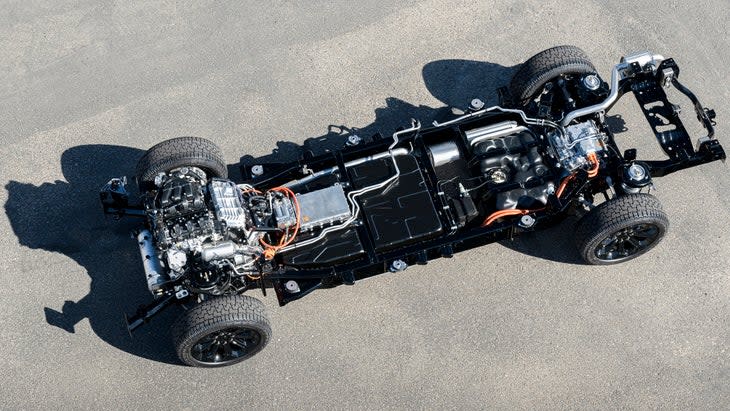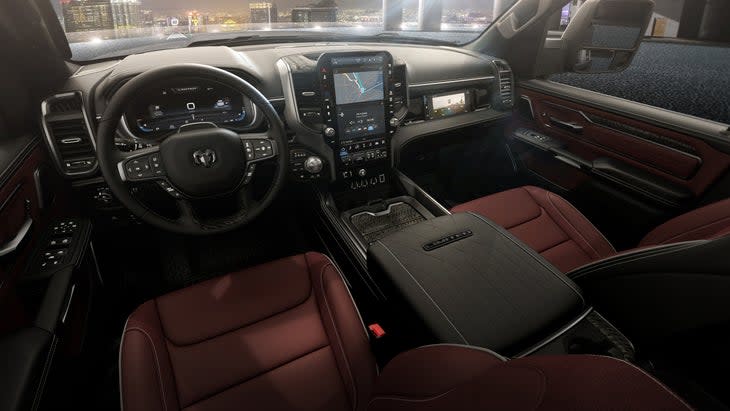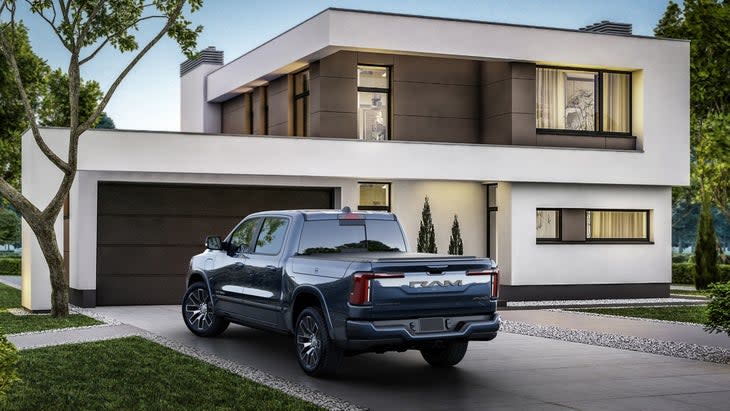Is This New Plug-In Hybrid The Ideal Eco-Friendly Truck?
This article originally appeared on Outside
Electric pickup trucks look great on paper, but they come up short when it’s time to do actual work. Are vehicles like the Rivian R1T, Ford F-150 Lightning, and GMC Hummer EV fast? Definitely. Efficient? They're better than their internal combustion engine (ICE) equivalents. But practical for hauling? Not really. And that's the issue Ram is trying to solve with this new Ramcharger. Adding an ICE to an electric truck should eliminate concerns about range, while adding the ability to tow.
And I do mean it when I say this thing is an EV. The Ramcharger is built on the same frame--dubbed STLA by parent company Stelantis--as the upcoming all-electric Ram 1500 REV, and powers its two electric motors using a large 92 kilowatt-hour (kWh) battery. The big difference between the Ramcharger and other electric trucks is that when that battery begins to run low, a 3.6-liter gasoline V6 kicks in and generates power.
The gas engine never directly powers the wheels, and there is no mechanical connection between those parts. It only drives a 130 kW generator, from which electricity can be drawn to recharge the battery, or, in combination with the battery, power the drive motors.

Running on battery power alone, Ram says the Ramcharger can travel up to 145 miles when the truck is unladen. Combined, its two electric motors product 663 horsepower and 615 pound-feet of torque. That's good for a 0-60 miles per hour sprint in just 4.4 seconds. But more impressive are the Ramcharger's payload and towing capacities, which are 2,625 and 14,000 pounds respectively.
Compare those numbers--a measure of how hard a truck is able to work--to other electric pickups. The Rivian can only haul 1,760 pounds and tow 11,000 pounds. With a 1,300 pound payload, the Hummer EV can't safely carry five American-sized adults, and only tows 8,500 pounds. The Ford F-150 Lightning manages up to 2,235 pounds of capacity, but only with the small 98 kWh battery. Add the 131 kWh pack to extend unladen range to 300 miles and you're only moving 1,657 pounds. The extended range Lightning can tow up to 10,000 pounds in some configurations, but struggles mightily with range while doing so. In a Motor Trend test, towing an 8,500 pound trailer reduced the Lightning’s range to under 100 miles, even with the big battery. All the other EV trucks would perform similarly, if not worse.
And that's the Ramcharger's reason for being. The battery and gas engine will work together to extend range for as long as you're able to keep adding gas to the 27-gallon tank. Cross country road trips, or long-distance off-road travel will be as easy they are in an ICE pickup. Need more range? Carry a jerry can.
And using a charging station will be optional. That might offer some advantages in normal driving--filling up with gas is still much faster than charging a battery--but will be a real boon while towing. Most charging stations aren't pull through, meaning you need to disconnect the trailer before reversing into one, and while EV batteries charge very quickly around the middle of their capacity, charging from a nearly depleted state or completely topping off a battery can take a much longer time, and those conditions are typical needs for people pulling trailers.
With its on-sale date still a year or more out, Ram isn't yet releasing full details of the Ramcharger. But the vehicle's chief engineer Doug Killian did explain to me in broad strokes how the battery and generator will work together.
In Electric Plus mode, Killian explains that the generator will remain off no matter how much performance the driver requests from the vehicle. The Ramcharger can return that 4.4 second 0-60 MPH performance using only battery power. With Electric Plus enabled, the truck will run only on the battery until charge drops to about 20 percent (Ram is still developing final calibrations), at which point the generator will kick in, and start recharging the battery.
In Tow mode, Killian says the generator will kick in much earlier to maintain a high state of charge for the battery, so that full power remains available to pull a heavy trailer up a steep hill or into a stiff headwind.
The Ramcharger is also fitted with variable height air suspension. While towing or hauling a heavy load, that will maintain the vehicle's normal ride height, and optimize suspension geometry for efficient, safe operation. That air suspension can be lowered in Sport mode, which will create negative camber by tilting the tops of the tires inwards. In addition to sharper throttle response, this will also sharpen steering and improve grip on paved roads.
That suspension will increase in height in one of the Ramcharger's two off-road modes. Killian doesn't yet have final numbers on how much lift that will create, but does say there will be an optional off-road package that will include a locking rear differential.

On traditional ICE vehicles, the front and rear axles are mechanically connected by drive shafts running into a differential or transfer case. Locking the speeds of those axles together to enter four-wheel drive only allows the wheel on one axle with the least traction to spin as fast as its counterpart on the opposite axle. EVs don't typically rely on a mechanical connection, but instead match axle speeds using software. When things get really slippery, or a wheel is in the air, four-wheel drive is functionally two-wheel drive. To increase traction further, you need to match wheel speeds across axles too. On the Ramcharger, that will be handled by an electronically-actuated mechanical locking differential on the rear axle. The front axle differential will remain open, but Killian says a modern brake-based traction aid will help there.
Killian explains that, while wheel travel and articulation on the Ramcharger will be, "a little behind" ICE Ram 1500s due to the additional weight of the EV, off-road development for the vehicle was conducted on the same trails and terrain as the ICE trucks, and buyers can expect one-to-one parity in capability between Ramcharger and the regular Ram 1500. Tire size for Ramcharger is 275/50-22, which translates to a diameter of 32.8 and a width of 10.8 inches.
There's also a battery preservation mode, which Killian says is for drivers who want to "get into camp with a full battery." The Ramcharger includes a 7.2 kW power panel in the bed, which is more than enough power to run tools, camping gear, power an RV, or charge electric bicycles or dirt bikes. Killian is also still working on final calibrations for the level of capacity owners will be able to draw the Ramcharger's battery down to, but suggests it will be in the region of 90 percent. It's hard to overstate how much capacity 82 kilowatts or so offers. That'd be enough to run a 1500 Watt space heater for 54.6 consecutive hours, for example. Importantly, that's enough juice to run a camper's air conditioning without the need to connect to shore power, so the Ramcharger will free drivers with large campers or trailers from RV parks.
In another boon to overlanders and RVers, Ramcharger's towing and payload capacities are higher than the ICE Ram 1500, which is quite an achievement given that suspension on the EV is fully independent (solid axles, as used on ICE pickups, are usually better at supporting weight). Killian told me he achieved this simply by designing the STLA platform's suspension around high weight capacities, beefing up parts like bushings and motor cooling capacities to suit the work owners expect trucks to perform.
Killian acknowledges that the Ramcharger will not be the greenest vehicle ever made, nor even the most efficient Ram pickup. Ram is also releasing a 100 percent electric truck built on the same platform. Dubbed the Ram 1500 REV, it will feature 168 or 229 kWh batteries--the latter good for up to 500 miles of unladen range.
"The Ramcharger is really designed for that EV owner who wants to drive long distances, but doesn't want to worry about range anxiety," says Killian. "It tows just as well as an ICE Ram 1500."
Running some basic math on the 690-mile max towing range Ram is quoting and the Ramcharger’s 27-gallon fuel tank capacity yields an estimated 20 miles per gallon of total fuel economy. I asked Killian if that was an accurate assessment of Ramcharger's efficiency. "Yes," he responded, "but only while operating in tow mode."
There are no official EPA test cycle fuel economy figures for the vehicle yet. Actual efficiency will vary heavily, depending on how the vehicle is used. While towing a heavy trailer may result in even lower efficiency, commutes with less than 145 miles between charges will look just like commutes in any other EV--zero tailpipe emissions. Efficiency on trips above that mileage will depend on how often you're able or want to stop at a charging station. You'll be able to operate off-road in nearly-silent Electric Plus mode, which will be appreciated by both casual nature lovers and hunters alike, and unlike other plug-in hybrids, you'll be able to do that over long distances.
The Ramcharger is a seriously thorough effort to give EV drivers the real world practicality they need to use their vehicles away from urban areas and in situations beyond basic commuting. While operating in Tow Mode the Ramcharger may only return fuel efficiency similar to that of half-ton pickups, and like those trucks that will fall farther while actually towing. But in other scenarios, we're looking at anything from zero to very few tailpipe emissions (we'll know more as more details are released).
Pickup trucks are America's second most popular vehicle (after crossovers), and the most polluting, but represent a necessary evil for their owners. No other type of vehicle is able to combine space for families with the ability to tow and haul, and to go off-road. Existing EV trucks have only been able to handle one or two of those jobs. The Ramcharger can do all three.
The other reality we must acknowledge in any discussion of EVs is that America's charging infrastructure sucks. China, for example, builds more charging stations per month than exist in this country, total. While home chargers are cheaper than ever, they can't help you when you're not home. While cities may appear to have ample charging options, their speeds and compatibilities vary, and many charging networks are poorly maintained, frequently resulting in broken equipment. While major highways may offer plentiful charging options, rural routes still don't. And while blue states managed by competent governance may be doing all they can to expand charging infrastructure, red states run by culture warriors are doing their level best to sabotage EV adoption. The Ramcharger will free drivers from that mess, giving them a vehicle that is capable not only of operating with zero tailpipe emissions, but also one capable of traveling away from city centers.
Right now, there is not a one-vehicle solution for households that want to create less pollution, but also need a truck for doing truck stuff. When it goes on sale late next year, the Ramcharger will be that option.

And while it may not operate as efficiently as an all-electric luxury car like a Tesla, the Ramcharger will still significantly reduce emissions when compared to an ICE pickup. Cradle to grave, the total emissions created by manufacturing, driving, and recycling EVs are around half those produced by doing the same with an equivalent ICE vehicle, even using our relatively dirty electrical grid. Cutting already-efficient luxury car emissions in half is important and all, but slashing total emissions across America's vast fleet of heavily polluting trucks would be an achievement that might actually move the needle on climate change.
I guess what I'm saying here is that, by polluting a little more than a pure electric vehicle, the Ramcharger holds the potential to help our country pollute a whole lot less.
Is there a caveat? Yes. Ram is not talking pricing for the Ramcharger yet, but assuming a cost of $150 per-kilowatt hour for the 92 kWh battery pack, we're looking at $13,800 in batteries alone. And unlike with traditional EVs, that will be in addition to the price of the gas engine. We can't quite just add the cost of the batteries to an ICE Ram 1500 as Ramcharger is built on a totally new chassis and there's many other unique systems on this vehicle, but it is safe to assume the Ramcharger will demand a significant premium. And likely one that won't result in cost savings until it's been driven many tens of thousands of miles.
Ultimately, fully understanding and appreciating the Ramcharger involves nuance. While it's capable of operating with zero tailpipe emissions, it'll also be capable of producing pretty atrocious fuel economy numbers while towing a heavy trailer. The advantage is that it’s the first EV that can realistically take that trailer on long tripes. And while using it carefully could add up to massively reduced emissions versus driving an equivalent gas or diesel, you'll need to care enough about reducing your carbon footprint to pay a hefty premium for the privilege of polluting less. And that will rule the vehicle out for many budget-conscious buyers. Still, the Ramcharger is, for the first time, an entirely practical electric pickup. And that's a significant achievement, whether you'll be able to afford to buy one or not.
For exclusive access to all of our fitness, gear, adventure, and travel stories, plus discounts on trips, events, and gear, sign up for Outside+ today.

